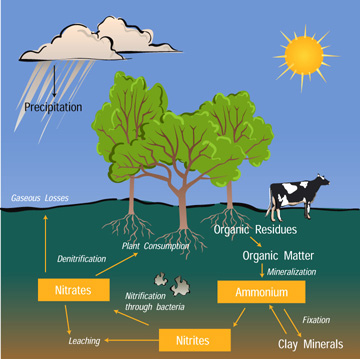This picture shows how nitrogen moves between living and non-living parts of our planet.
Click on image for full size
NCAR
The Nitrogen Cycle
Nitrogen is a part of living things like
plants and
animals. Nitrogen is also a part of non-living things like the air above and the dirt below. Nitrogen does not stay in one place. It moves slowly between living things, dead things, the air, soil and water. These movements are called the
nitrogen cycle.
On our planet, most nitrogen is in the atmosphere. About four out of five air molecules are nitrogen. All plants and animals need nitrogen to grow, but the nitrogen that is in the atmosphere is not the type that they can use. Nitrogen in the air can be changed during lightning strikes, during fires, and by special bacteria, and becomes the type that plants and animals need to grow.
Most plants get the nitrogen they need to grow from the soil or water in which they live. Animals get the nitrogen they need by eating plants or other animals that contain nitrogen. When organisms die, their bodies decay and the nitrogen in them is released into soil or into ocean water.
Last modified May 7, 2007 by Lisa Gardiner.
You might also be interested in:

Each Eubacteria is a tiny prokaryotic cell. Some can make food from sunlight through photosynthesis. Cyanobacteria, also called blue-green algae, are able to do this. They have been living in the oceans
...more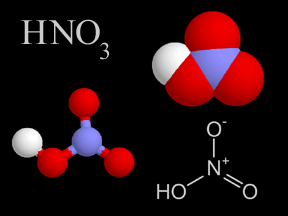
Nitric acid is a very strong kind of acid. If you got some on your skin, it would burn you! Nitric acid has nitrogen, oxygen, and hydrogen atoms in it. Earth's atmosphere has a very, very tiny bit of nitric
...more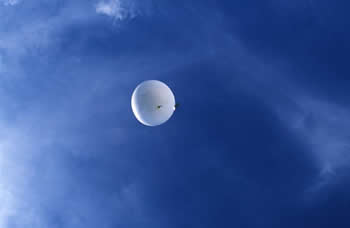
You can’t see air molecules. But if you could, you would see that most of them are made of two atoms of nitrogen bonded together. Nitrogen is not just in the sky. It is found all over the planet. It is
...more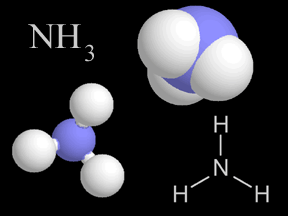
Ammonia is a kind of gas. Ammonia molecules (NH3) have hydrogen and nitrogen atoms in them. The air you breathe has a tiny bit of ammonia in it. When plants and animals die and decay, they give off ammonia.
...more
Chemistry is the study of matter, energy, and how they effect each other. Chemists study the what substances are made of and what they do, and how they react with each other. Chemists work to develop new
...more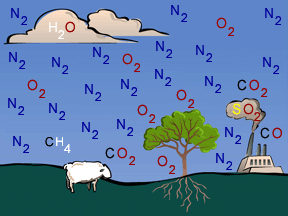
When you think of chemistry, do you think about mixing colored liquids in test tubes and maybe making an explosion... or at least a nice puff of smoke? Did you know that a lot of chemistry happens in Earth's
...more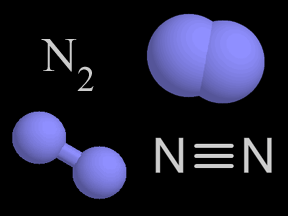
There is more nitrogen gas in the air than any other kind of gas. About four out of five of the molecules in Earth's atmosphere is nitrogen gas! A molecule of nitrogen gas is made up of two nitrogen atoms.
...more


